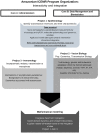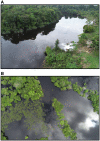Malaria Resilience in South America: Epidemiology, Vector Biology, and Immunology Insights from the Amazonian International Center of Excellence in Malaria Research Network in Peru and Brazil
- PMID: 36228921
- PMCID: PMC9662219
- DOI: 10.4269/ajtmh.22-0127
Malaria Resilience in South America: Epidemiology, Vector Biology, and Immunology Insights from the Amazonian International Center of Excellence in Malaria Research Network in Peru and Brazil
Abstract
The 1990s saw the rapid reemergence of malaria in Amazonia, where it remains an important public health priority in South America. The Amazonian International Center of Excellence in Malaria Research (ICEMR) was designed to take a multidisciplinary approach toward identifying novel malaria control and elimination strategies. Based on geographically and epidemiologically distinct sites in the Northeastern Peruvian and Western Brazilian Amazon regions, synergistic projects integrate malaria epidemiology, vector biology, and immunology. The Amazonian ICEMR's overarching goal is to understand how human behavior and other sociodemographic features of human reservoirs of transmission-predominantly asymptomatically parasitemic people-interact with the major Amazonian malaria vector, Nyssorhynchus (formerly Anopheles) darlingi, and with human immune responses to maintain malaria resilience and continued endemicity in a hypoendemic setting. Here, we will review Amazonian ICEMR's achievements on the synergies among malaria epidemiology, Plasmodium-vector interactions, and immune response, and how those provide a roadmap for further research, and, most importantly, point toward how to achieve malaria control and elimination in the Americas.
Figures



Similar articles
-
Evidence-Based Malaria Control and Elimination in the Amazon: Input from the International Center of Excellence in Malaria Research Network in Peru and Brazil.Am J Trop Med Hyg. 2022 Oct 11;107(4_Suppl):160-167. doi: 10.4269/ajtmh.21-1272. Print 2022 Oct 11. Am J Trop Med Hyg. 2022. PMID: 36228907 Free PMC article. Review.
-
Malaria vector species in Amazonian Peru co-occur in larval habitats but have distinct larval microbial communities.PLoS Negl Trop Dis. 2019 May 15;13(5):e0007412. doi: 10.1371/journal.pntd.0007412. eCollection 2019 May. PLoS Negl Trop Dis. 2019. PMID: 31091236 Free PMC article.
-
Vector competence, vectorial capacity of Nyssorhynchus darlingi and the basic reproduction number of Plasmodium vivax in agricultural settlements in the Amazonian Region of Brazil.Malar J. 2019 Apr 4;18(1):117. doi: 10.1186/s12936-019-2753-7. Malar J. 2019. PMID: 30947726 Free PMC article.
-
Microsatellite data suggest significant population structure and differentiation within the malaria vector Anopheles darlingi in Central and South America.BMC Ecol. 2008 Mar 26;8:3. doi: 10.1186/1472-6785-8-3. BMC Ecol. 2008. PMID: 18366795 Free PMC article.
-
Amazonian malaria: asymptomatic human reservoirs, diagnostic challenges, environmentally driven changes in mosquito vector populations, and the mandate for sustainable control strategies.Acta Trop. 2012 Mar;121(3):281-91. doi: 10.1016/j.actatropica.2011.10.001. Epub 2011 Oct 12. Acta Trop. 2012. PMID: 22015425 Free PMC article. Review.
Cited by
-
Ecological change increases malaria risk in the Brazilian Amazon.Proc Natl Acad Sci U S A. 2024 Oct 29;121(44):e2409583121. doi: 10.1073/pnas.2409583121. Epub 2024 Oct 21. Proc Natl Acad Sci U S A. 2024. PMID: 39432796 Free PMC article.
-
Population genomic evidence of structured and connected Plasmodium vivax populations under host selection in Latin America.Ecol Evol. 2024 Mar 24;14(3):e11103. doi: 10.1002/ece3.11103. eCollection 2024 Mar. Ecol Evol. 2024. PMID: 38529021 Free PMC article.
-
Malaria seroepidemiology in very low transmission settings in the Peruvian Amazon.Sci Rep. 2024 Feb 2;14(1):2806. doi: 10.1038/s41598-024-52239-5. Sci Rep. 2024. PMID: 38307878 Free PMC article.
-
Recurrence patterns and evolution of submicroscopic and asymptomatic Plasmodium vivax infections in malaria-endemic areas of the Peruvian Amazon.PLoS Negl Trop Dis. 2024 Oct 31;18(10):e0012566. doi: 10.1371/journal.pntd.0012566. eCollection 2024 Oct. PLoS Negl Trop Dis. 2024. PMID: 39480785 Free PMC article.
-
Lower Microscopy Sensitivity with Decreasing Malaria Prevalence in the Urban Amazon Region, Brazil, 2018-2021.Emerg Infect Dis. 2024 Sep;30(9):1884-1894. doi: 10.3201/eid3009.240378. Emerg Infect Dis. 2024. PMID: 39174028 Free PMC article.
References
-
- WHO , 2021. World Malaria Report. Geneva, Switzerland: World Health Organization.
-
- Vittor AY Gilman RH Tielsch J Glass G Shields T Lozano WS Pinedo-Cancino V Patz JA , 2006. The effect of deforestation on the human-biting rate of Anopheles darlingi, the primary vector of Falciparum malaria in the Peruvian Amazon. Am J Trop Med Hyg 74: 3–11. - PubMed
Publication types
MeSH terms
Grants and funding
LinkOut - more resources
Full Text Sources
Medical

